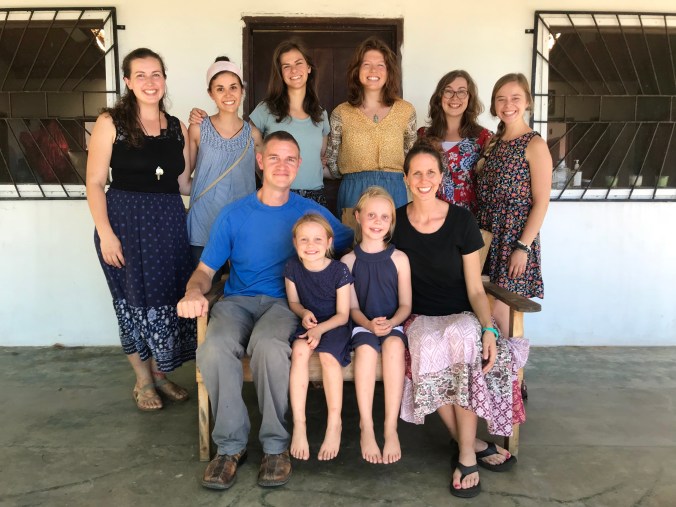One year ago today, our family announced to the world that Adelina had tested positive for Dengue Fever and we would be coming home from Honduras.
Usually, when I’m reminded of the anniversary of an event (thank you, Facebook “memories” feature), I am shocked to discover that a year has passed. But that feels like only yesterday!
Well, not this time.
Only a year? How is that possible? It feels like 5 years have passed… or maybe a lifetime or two – since we were a Finca missionary family. Between now and then, we have gone through so many transitions and iterations of life that I’m not even sure I could name them all.
A pithy overview: Returned to the U.S., spent 6 months as “those millennials” living with parents, found a new congregation for Eric, bought a fixer-upper, tried to fix up said fixer-upper, moved, started at a new church/school, finally got into a routine, went into lockdown for Covid. It’s been a whirlwind of a year.

On a recent family hike near our new home in Washington
And writing the narrative that preceded this year, the narrative of our time in Honduras?
There’s the one-sentence answer: “It was beautiful and hard and ended abruptly due to illness.” There’s the much longer version, which, depending on my vibe, focuses more on either the beautiful or the hard.
And then there’s the real truth, which is that we’re still a bit baffled by all of it – our call to mission, our time in Honduras, and our unexpected return.
A college friend wrote a beautiful article a while back. Her reflections on the year she spent trying to keep a convent of elderly nuns together in their home (an unsuccessful endeavor) resonate deeply with me today:
I feel like my 6-year-old nephew, who, upon reaching the top of a mountain (after weeks of anticipation and the eventual arduous climb), looked around at the expansive sky, the drifting clouds, the distant hills and said — “Well, what was that all about?”
What was that all about?
Indeed. Our years of dreaming about being a missionary family, the months spent in preparation, the exhausting learning curve upon our arrival, the everyday joys and frustrations of life on the Finca, and then… the Dengue. The hurried goodbyes. The months of waiting for “the next step” of our life journey to reveal itself.
What was that all about?
When we first returned, I had a hard time letting go of the Finca. Every time I looked at a clock, I would calculate what activities were taking place at the Finca at that very moment. I read and re-read emails I’d sent to friends from the Finca. I worked compulsively on the solar energy project (which is now –like the rest of the world—on indefinite hold due to Covid-19 restrictions).
In November, I was blessed with the opportunity to visit the Finca and help train the new missionaries on the tasks I had performed. It was a bittersweet week for me. On the one hand, I was overjoyed to see the Finca community again: to pray in the church, to meet the new missionaries, to relive the vivid sights, sounds, and smells of the place. On the other hand, I felt sadness and frustration that our whole family wasn’t there, living out the mission we’d envisioned. Our family’s last few weeks at the Finca were so riddled with illness that I hadn’t been able to be fully present to the community; our exodus was so hasty and stressful that it was difficult to parse my feelings about our departure from my feelings about the Finca.
Being back there, surrounded by tropical fauna, beautiful souls, and complicated memories, I felt… a bit cheated. Our family’s life on the Finca seemed unjustly ephemeral.
A tangent, if you’ll allow me…
Many years ago, I bought a just-published paperback edition of a novel. The publisher must have had some kind of problem during printing, because right in the middle of a chapter, the book pages suddenly went blank. I turned page after page –probably 25 in all—before the words finally resumed. At first, I struggled to understand what was happening in the plot because of the missing pages; eventually, though, I pieced together the necessary information to follow along. By the end of the book, I was confident I’d gleaned the whole picture.
I don’t think I’ve gleaned the whole picture of our life on the Finca just yet. Right now, it feels like a chapter that just went blank halfway through, and I’m still trying to figure out how it fits together with the chapters we are living right now. I’m not sure I’ll ever be able to fully answer the question, what was that all about?

But I know I’m glad we went. I know I’ll be back again. And I know that God was there on every page of that crazy Finca chapter – the pages that are bursting with joy, the pages that are full of lament, and the pages that, right now, seem totally empty. Because, at the end of the day, each and every one of those pages – indeed, all of the chapters of the book – are not actually ours… they belong to a much bigger book, a Great Love Letter, that has been in God’s hands, and not our own, all along.
I have faith that – one day – we’ll get to read the whole thing.
































